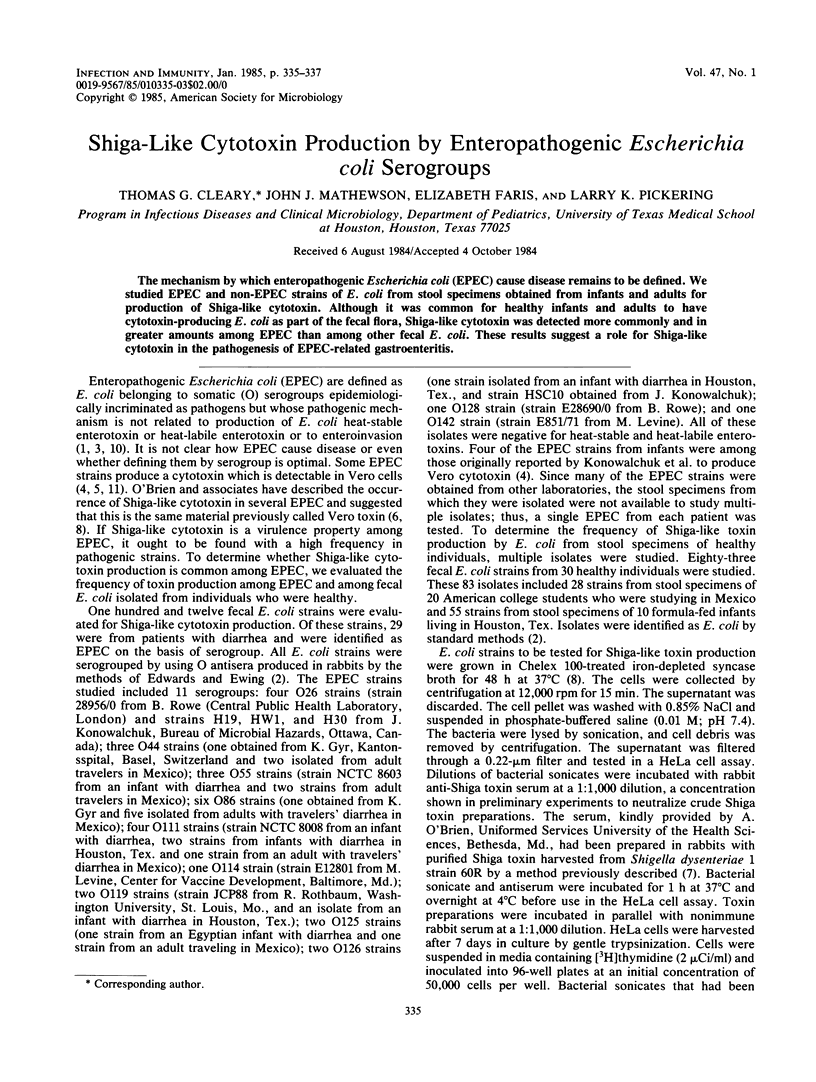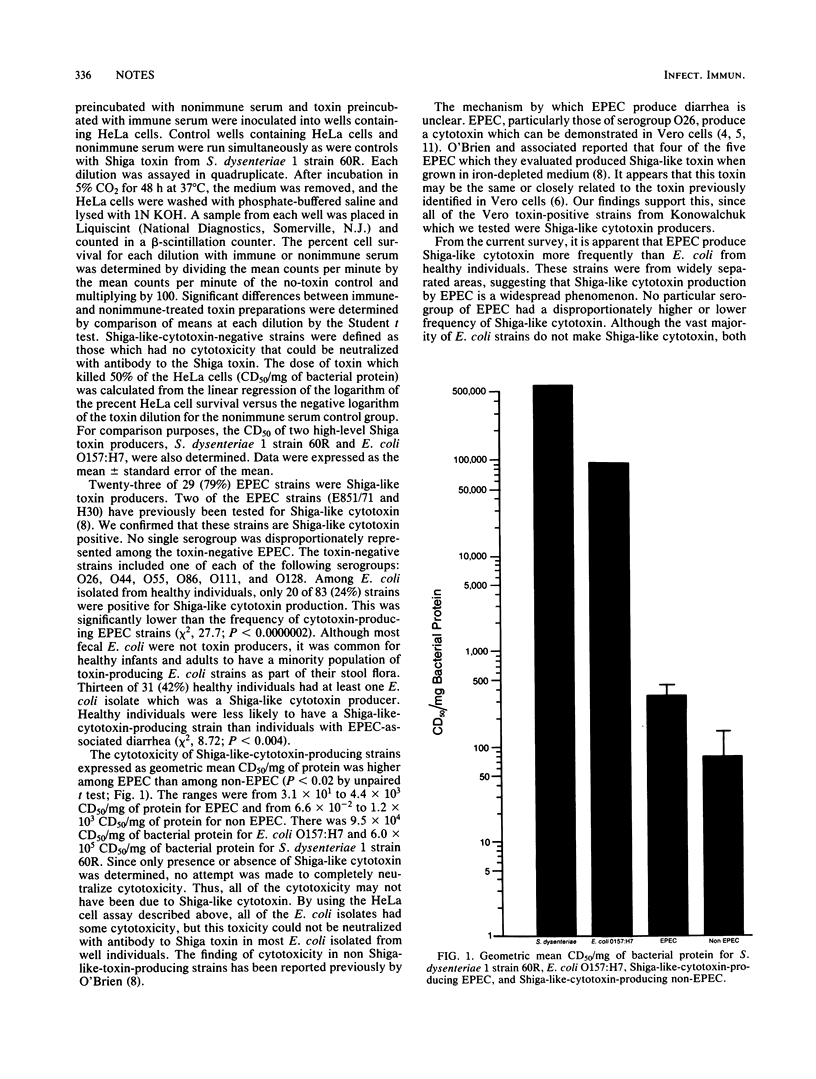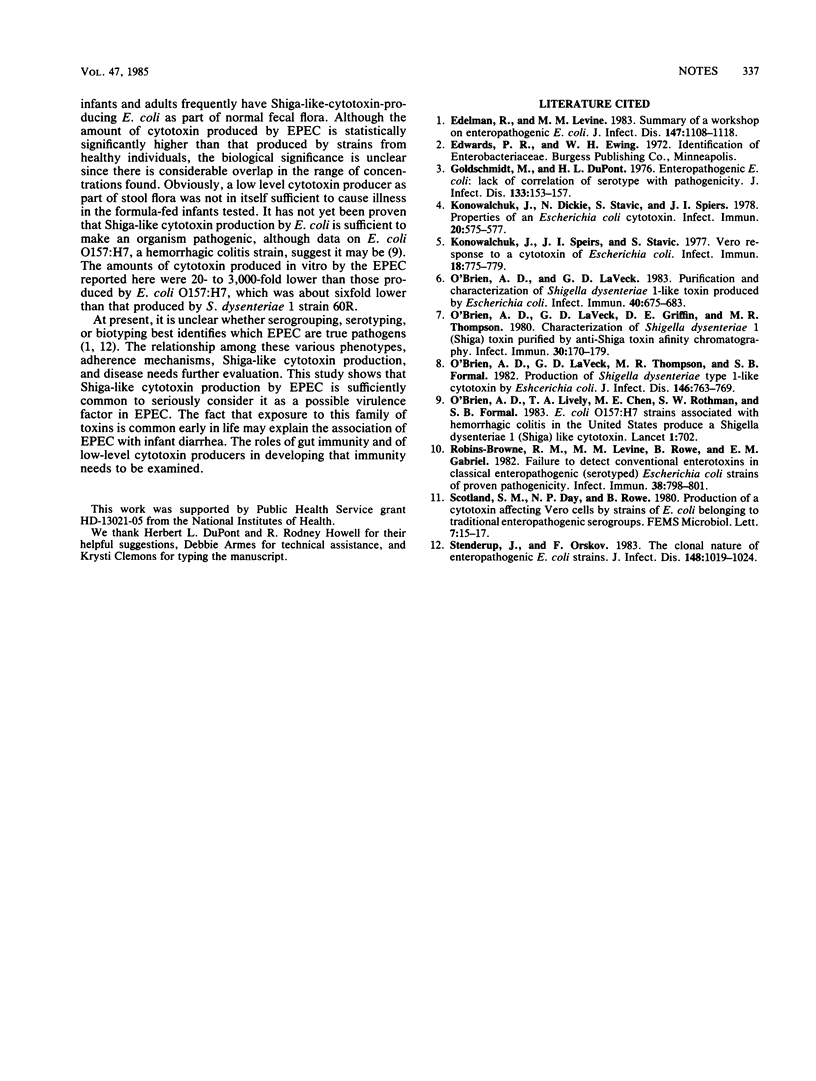Abstract
The mechanism by which enteropathogenic Escherichia coli (EPEC) cause disease remains to be defined. We studied EPEC and non-EPEC strains of E. coli from stool specimens obtained from infants and adults for production of Shiga-like cytotoxin. Although it was common for healthy infants and adults to have cytotoxin-producing E. coli as part of the fecal flora, Shiga-like cytotoxin was detected more commonly and in greater amounts among EPEC than among other fecal E. coli. These results suggest a role for Shiga-like cytotoxin in the pathogenesis of EPEC-related gastroenteritis.
Full text
PDF


Selected References
These references are in PubMed. This may not be the complete list of references from this article.
- Edelman R., Levine M. M. From the National Institute of Allergy and Infectious Diseases. Summary of a workshop on enteropathogenic Escherichia coli. J Infect Dis. 1983 Jun;147(6):1108–1118. doi: 10.1093/infdis/147.6.1108. [DOI] [PubMed] [Google Scholar]
- Goldschmidt M. C., DuPont H. L. Enteropathogenic Escherichia coli: lack of correlation of serotype with pathogenicity. J Infect Dis. 1976 Feb;133(2):153–156. doi: 10.1093/infdis/133.2.153. [DOI] [PubMed] [Google Scholar]
- Konowalchuk J., Dickie N., Stavric S., Speirs J. I. Properties of an Escherichia coli cytotoxin. Infect Immun. 1978 May;20(2):575–577. doi: 10.1128/iai.20.2.575-577.1978. [DOI] [PMC free article] [PubMed] [Google Scholar]
- Konowalchuk J., Speirs J. I., Stavric S. Vero response to a cytotoxin of Escherichia coli. Infect Immun. 1977 Dec;18(3):775–779. doi: 10.1128/iai.18.3.775-779.1977. [DOI] [PMC free article] [PubMed] [Google Scholar]
- O'Brien A. D., LaVeck G. D., Griffin D. E., Thompson M. R. Characterization of Shigella dysenteriae 1 (Shiga) toxin purified by anti-Shiga toxin affinity chromatography. Infect Immun. 1980 Oct;30(1):170–179. doi: 10.1128/iai.30.1.170-179.1980. [DOI] [PMC free article] [PubMed] [Google Scholar]
- O'Brien A. D., LaVeck G. D. Purification and characterization of a Shigella dysenteriae 1-like toxin produced by Escherichia coli. Infect Immun. 1983 May;40(2):675–683. doi: 10.1128/iai.40.2.675-683.1983. [DOI] [PMC free article] [PubMed] [Google Scholar]
- O'Brien A. D., LaVeck G. D., Thompson M. R., Formal S. B. Production of Shigella dysenteriae type 1-like cytotoxin by Escherichia coli. J Infect Dis. 1982 Dec;146(6):763–769. doi: 10.1093/infdis/146.6.763. [DOI] [PubMed] [Google Scholar]
- O'Brien A. O., Lively T. A., Chen M. E., Rothman S. W., Formal S. B. Escherichia coli O157:H7 strains associated with haemorrhagic colitis in the United States produce a Shigella dysenteriae 1 (SHIGA) like cytotoxin. Lancet. 1983 Mar 26;1(8326 Pt 1):702–702. doi: 10.1016/s0140-6736(83)91987-6. [DOI] [PubMed] [Google Scholar]
- Robins-Browne R. M., Levine M. M., Rowe B., Gabriel E. M. Failure to detect conventional enterotoxins in classical enteropathogenic (serotyped) Escherichia coli strains of proven pathogenicity. Infect Immun. 1982 Nov;38(2):798–801. doi: 10.1128/iai.38.2.798-801.1982. [DOI] [PMC free article] [PubMed] [Google Scholar]
- Stenderup J., Orskov F. The clonal nature of enteropathogenic Escherichia coli strains. J Infect Dis. 1983 Dec;148(6):1019–1024. doi: 10.1093/infdis/148.6.1019. [DOI] [PubMed] [Google Scholar]


